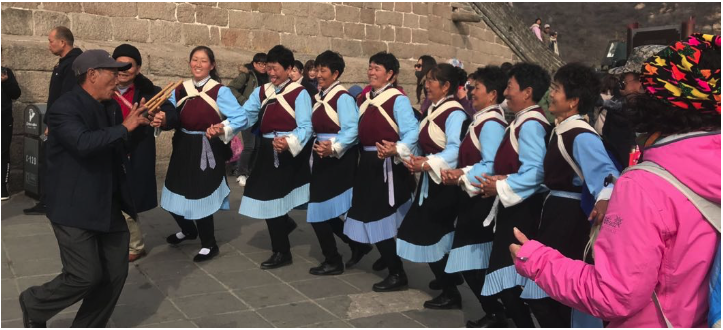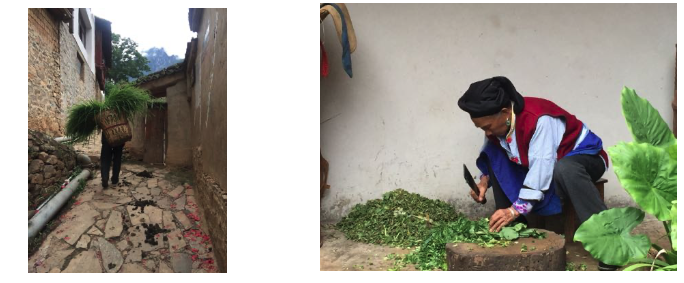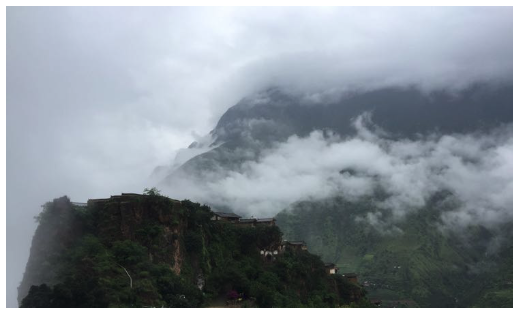Introduction
Surrounded by the undulating waves of mountains and the sinuous Jinsha River is a secluded small village—dabbed the Baoshan Stone Village by the locals—located 110 km from Lijiang and barely touched by the clamor of the outside world (Lei, 2011, para. 5). While the Stone Village is neither as reputable nor economically prosperous as other popular tourist sites in China, it is certainly a territory not to be underestimated by its sheer size and lack of fame among outsiders and amateur travelers. As a matter of fact, the village itself has (astonishingly) resided on the top of a mountain cliff on a single megalith for about 800 years, raising unceasing generations of the people of the Naxi ethnic group thanks to the nurture of the Jinsha River and the vast green mountains’ embrace (Lei, 2011, para. 3). If we are to consider the difficulty of accessing a historic site nowadays that has not yet been “trampled” by endless flocks of sightseers, it is indeed lucky enough for me to set foot in and get to know about this mysterious village whose lands remained unprofane, culture unperturbed, and history seemingly devoid of temporality. Problems concern- ing the future development and long-term sustainability of the Stone Village, however, seem to arise when the historical heritage of the Naxi people is forced to confront new challenges posed by modernity.
Historical Background
The first emergence of the Stone Village dated back to about 800 years ago, when Kublai Khan, the founder and first emperor of the Yuan Dynasty, cleverly made the naturally well-guarded terri- tory (since it had been surrounded by mountain ranges and rivers in addition to residing on a megalith) into a frontier juncture, which gradually developed into an unconquerable fortress to protect China against foreign invasion (Lei, 2011, para. 3). Largely due to the village’s defensive geographic location, residents headed by the Naxi chief began moving into and prospering in the seemingly uninhabitable village-on-a-cliff. Generations later, its inhabitants’ composition basically unchanged (that is, most of them are of the Naxi minority ethnic group), the fortress evolves into the Stone Village we could still see today.
Naxi People and their Culture
One could hardly say he knows a place well without actually knowing about the most fundamental component of civilizations—its people, upon which the habitat’s basic traits and culture are based. Whereas various other ethnicities (though small in quantity) are present in the Stone Village like in anywhere else in modern-day China, the people of the Stone Village are mostly of the Naxi ethnic minority group, a group that maintains its distinct ethnic culture even in modern times and whose majority of people continuously reside in the Yunnan Province (“The Naxi Ethnic Minority,” n.d., para. 1). These Naxi people have been able to develop and preserve their own festivals, arts and music, as well as architectural characteristics through the course of history.
Festivities
In addition to the Spring Festival and the Tomb Sweeping Festival which the majority of Chinese people (those of the Han ethnic group) celebrate, Naxi people in the Stone Village also celebrate their own Sandong Festival, Dongyue Festival, as well as Torchlight Festival. Since most Naxi people are said to be faithful and value festivities and celebrations highly, those who work in the cities are obliged to come home—whether in rural towns or desolate villages—to reunite with their families and to honor their ancestors in the Spring Festival and Tomb-Sweeping Festival break, respectively. In contrast, the Naxis’ own festivities are much freer and less compulsory than the former two traditional Chinese festivities, according to a traditional Naxi family we interviewed. People get to choose whoever they want to hold celebrations with (whether it be their family mem- bers, friends, or neighbors) at any location they may prefer on the Sandong Festival with the sole requirement that they have to be respectful to the Sandong god by making simple food tributes to him. Other unique and intriguing means of celebrations of the Naxi people entail bathing on the Sandong Festival to (both corporeally and spiritually) wash off anything impure from the bodies, slaughtering pigs and praying for rainfall in the Dongyue Festival, and killing moths and other insects in the Torchlight Festival. Contrary to what we have previously assumed before interview- ing the village’s local residents, these festivals are not becoming less important with time. On the contrary, in addition to holding onto the rituals and celebrations for hundreds of years, many of the local inhabitants are actually starting to think of ways to revive or even accommodate their tradi- tions with the different demands of the modern society.
Arts and Music
As an ethnic group extremely fond of arts and music, villagers in the Stone Village traditionally participate in a wide range of such activities. A man we interviewed, Mr. Mu, gave us a vivid and romantic depiction of the way he and his wife used to sing to each other when working on the field in the “good old days.” The local Naxis of older generations strive to keep their traditional arts, songs, and dances intact by organizing art and music clubs in addition to establishing dancing rituals for all inhabitants who are interested to join. The owner of the inn I lived in during my sojourn in the Stone Village is a locally renowned singer who could melodiously sing many of the Naxis’ traditional songs (usually with high pitches and compelling rhythms); she has also estab- lished a singing and dancing club for the villagers (mostly the older population, since the young- sters have to work or study in big cities elsewhere) to join so as to teach them about both artistic skills and their ethnic group’s enduring culture and artistic traditions.

Nevertheless, unlike tradi- tional festival celebrations that have persisted for numerous generations, traditional Naxi artistic skills and capacities are unfortunately in decline. Not only are younger generations too busy or simply unwilling to learn about the village’s long-held artistic traditions due to their seeming futility in making a living, but the decline of agricultural practices have also deprived the only practicality of singing (farmhands entertaining themselves on the field to reduce the drudgery of heavy labor), providing no incentive for the villagers to pass on their precious cultural heritage. Fortunately, villagers are still willing to participate in newly established daily activities such as a form of dancing called “Da Tiao,” which is held every evening on a small plaza where everyone dances in circles to the rhythm of their recorded traditional songs (which are played on a giant music player). Such perseverance in daily dances not only offers villagers a chance to bond with one another but also helps to preserve the flickering flame of local Naxis’ interest in their unique forms of arts and music.
Architectural style
Along with the Naxi festivities and artistic traditions, inhabitants of the Stone Village have also developed their distinct architectural style. Interestingly, another source from which the location derives its name—the Stone Village—is the residents’ application of stones as building materials. While concrete has become a popular material for construction nowadays due to its relatively cheaper price, most of the village’s infrastructure and furniture are mostly built from wood and stones: from pebbled roads through which the villagers commute to stone and wooden tables, stove, and even beds to sleep on! The main reason for choosing wood and stones as building materials is rather obvious: Villagers use what are locally available to them to avoid paying for the expensive transportation fee of importing materials from elsewhere (carrying loads of heavy con- struction materials up a mountain would certainly not be inexpensive). The architectural style, according to a typical Naxi family we interviewed, has remained almost the same throughout the years; villagers who are unable to seek jobs or pursue careers outside of the Stone Village gener- ally opt to stay to eke out their living by learning to build the typical Naxi architecture. With the assistance of those who are still learning to preserve the traditional architectural skills, the Naxi-style houses are thankfully unlikely to perish in the near future.

Economic Predicaments
Nevertheless, it is no hard task to see and understand the economic predicaments the villagers face in a place fairly stripped of most modern technological developments. On one hand, people are just starting to enjoy the convenience of flush toilets, portable mobile devices, and Wi-Fi in recent years, which keep the reclusive village more or less in touch with the outside world; on the other hand, no new means of economic development have yet been discovered in spite of the apparent decline in farming practices. If all the farmhands laboring on the field are only of the older generations and those of the younger generations are reluctant to persist their own life on the field as the village head has accounted in our interview, the economic development will certainly cease in the near future when the village’s major dependable form of export, agricultural products, are no longer available for sale. The emigration rate from the mountain village is likely to continue to accelerate due to limited economic opportunities and job availabilities, which would leave the place a “ghost village” after a few decades (the nearby villages already have few residents left when we visited). It is therefore requisite for the Stone Village to come up with alternative means of survival other than growing and exporting agricultural products: The village must incorporate a less myopic and more sustainable development plan such as promoting tourism by taking advan- tage of Naxi people’s uniquely venerable cultural heritage.
Future Developmental Problems
Advancing tourism in a mountain village, however, is anything but an easy task, and the villagers are all too aware of that. Whereas the Stone Village is, fortunately, one of the few historical villag- es whose culture remains original and unperturbed by the outside world due to its geographic isolation, it has to be admitted that the village also confronts considerable problems precisely due to its desolate location. Unlike the majority of ancient Chinese villages and “boom towns” that are generating extensive revenue from tourism in cities and suburban areas, the Stone Village is nowhere easy for tourists to access despite advancements in transportations after the Industrial Revolution: Starting from the city of Lijiang in the Yunnan Province, it takes (on average) a 3-hour bus ride, a 2-hour boat voyage, and finally an arduous journey up the pebbled path in order to arrive at the village, making it no surprise that the village was unconquerable for foreign enemies. The roads are poorly constructed and preserved, which make them extremely susceptible to flood and debris flow due to high precipitation rate during summer times. The mere time and effort needed for traveling have already rendered the Stone Village in a disadvantageous position to win tourists’ favor. More importantly, the relationships between tourism and the preservation of heri- tage resources are characterized as both “symbioses and tensions” (Su & Wall, 2012, p. 1). Ms. Tian, an ecological expert conducting long-term research on the village has explained during our discussion that the ecological capacity is too limited to develop a sustainable tourism; local means of waste disposal—incineration and landfills—are by far incapable of disposing the prodigious amount of waste generated by tourists, not to mention the fact that the majority of villagers we interviewed simply did not favor the idea of allowing floods of outsiders into their historical village, thinking that they would sabotage their indigenous way of life as well as the ecological environment of the region.

Conclusion
The Naxi inhabitants of the Stone Village have undoubtedly come through a long way since their very first settlement and establishment of village life on the megalith, bequeathing their historical legacy, cultural traditions, and passion for arts and music from one generation to the next. After isolating itself from the outside world for almost a thousand years, the village has gradually start- ed making connections with the modern world—voluntarily or not—partially due to the ubiqui- tous infusion of today’s more widespread communication technology. In the face of declining dependability of traditional means of development and economic expediency to promote tour- ism, the villagers would have to find a way to reconcile their historical heritage with their need for modern conveniences and economic opportunities in order to maintain the livelihood of their evermore empty village. Naxi culture could perhaps only survive into and thrive in the far future by taking proper measurements such as improving commuting infrastructure within, increasing public awareness of and governmental assistance for, as well as compromising historical tradi- tions with modernity in the Stone Village.

Reference
Su, M, M. & Wall, G. (2012, November). Global–local relationships and governance issues at the Great Wall World Heritage Site, China. Retrieved from https://www.researchgate.net/pro- file/Ming_Su9/publication/254367247_Global- local_relationships_and_governance_is- sues_at_the_Great_Wall_World_Heritage_Site_China/links/54e7e0380cf27a6de10b4dbe/Globa l-local-relationships-and-governance-issues-at-the-Great-Wall-World-Heritage-Site-China.pdf
The Naxi ethnic minority. (n.d.). Retrieved from http://www.china.org.cn/e-groups/sha- oshu/shao-2-naxi.htm
Lei, C. (2011, August 01). Lijiang, ethnic minority. Retrieved from http://en.peo- ple.cn/102759/102835/7457036.html









